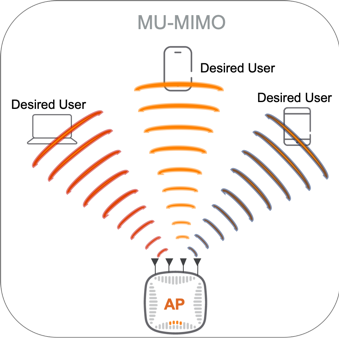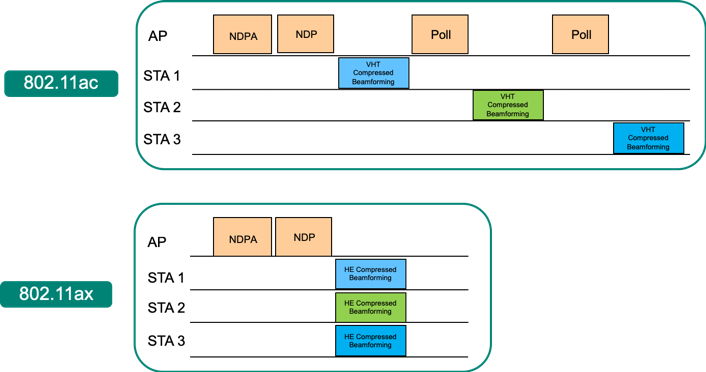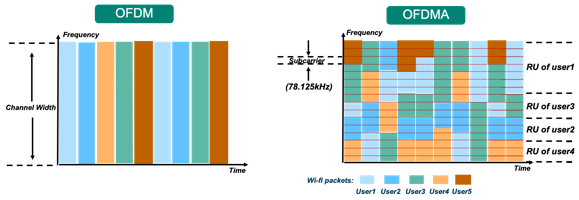The IEEE's latest standard, 802.11ax, has been designed inside and out for high efficiency. Also known as Wi-Fi 6, 11ax promises real-world performance improvements that will keep today’s mobile users and IoT devices connected and happy. To achieve that, over 50 features have been proposed to be part of the 11ax standard. Once adopted into the standard, they will be rolled out to the market in phases – Wave 1 and Wave 2, just like with 802.11ac.
Multi-user Multiple-Input, Multiple-Output (MU-MIMO) and Orthogonal Frequency-Division Multiple Access (OFDMA) are two of the most significant technical enhancements in 11ax. Both MU-MIMO and OFDMA are multiuser technologies that enable simultaneous bidirectional communication between an access point (AP) and end users. So how are they different?
Let's dive deeper into each technology, and explore how they have different uses.
MU-MIMO

In essence, the MU-MIMO technology remains the same between 11ac and 11ax. When multiple clients are trying to access the medium at the same time, the AP uses RF multipath to send frames to multiple clients at the same time instance. This technology is called MU-MIMO and it utilizes diversity in space. The difference between downlink MU-MIMO in 11ac and 11ax is that in the latter, the groups of clients are now bigger (up to eight clients in a group) instead of a maximum of four clients in one group. In contrast, MU-MIMO on the uplink is a new feature in 802.11ax that will roll out in the next phase of the standard.

The use of MU-MIMO in today's Wi-Fi devices has increased multifold and it is a commonly adopted technology in the Wi-Fi space. One of the drawbacks experienced in the 11ac flavor of MU-MIMO was the difficulty in forming client groups. Because of this, even a 4x4:4 spatial stream access point would seldom reap the benefits of higher gains as compared to Single-User MIMO. Downlink MU-MIMO in 11ax allows for up to eight clients to be grouped together.
As seen in the diagram above, APs can now group clients and transmit to these client groups in a sequential manner. The diagram represents beamforming reports, but this concept applies to other packet types as well. When uplink MU-MIMO is introduced in Wave 2 of 11ax, the bottleneck caused by acknowledgement mechanisms in the uplink will be eliminated and traffic over TCP/IP protocols will benefit from better performance on the uplink. Thus, MU-MIMO is a multiuser technology that increases capacity, facilitates higher speeds and is ideal for applications that require high bandwidths.
OFDMA

Orthogonal Frequency-Division Multiple Access (OFDMA) divides available channel bandwidth into several mutual orthogonal subcarriers or resource units (RUs). Access to multiple users is granted in OFDMA by assigning subsets of these subcarriers to individual users. Downlink OFDMA is one of the complex features of 11ax that allows a single downlink transmission (from AP to clients) to be split by frequency within a channel. Uplink OFDMA is similar to downlink OFDMA but in the reverse direction, i.e. from multiple clients to the AP. Since many clients will try to transmit at the same time, they need to be coordinated. To achieve this coordination, the AP sends trigger frames to the clients to inform them which subcarriers (or RUs) they can use to send data. OFDMA is also used by LTE networks as the means of multiuser transmission.
At first, it may appear as though OFDMA offers no added benefit as compared to single-user Orthogonal Frequency Division Multiplexing (OFDM) because the speed of transmit links remains unchanged. So, when half the channel is allocated for frame transmission in OFDMA, it would take twice the time. But, in OFDM, each time a frame transmission has to occur, there is significant overhead caused by medium contention. In OFDMA though, since transmit opportunities are shared by several frames bundled together, medium contention overhead is much lesser. Efficient use of the channel therefore leads to increased overall efficiency in small-packet applications in dense environments.
Two Technologies, Designed for Different Uses
OFDMA and MU-MIMO are thus complementary technologies. While OFDMA is ideal for low-bandwidth, small-packet applications such as IoT sensors, MU-MIMO increases capacity and efficiency in high-bandwidth applications like mission-critical voice calls and video streaming.
Related Content
Why OFDMA is a magical feature in 802.11ax standard
Three Ways 802.11ax Makes Wi-Fi Better




